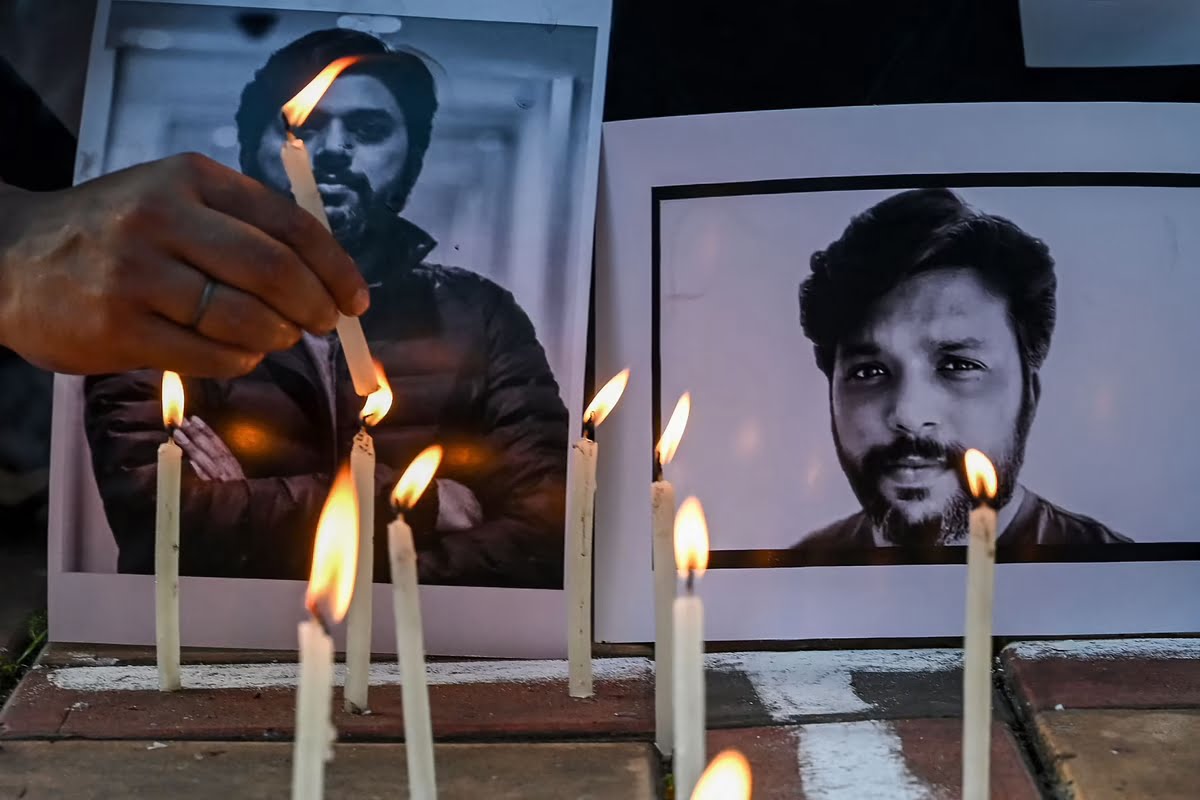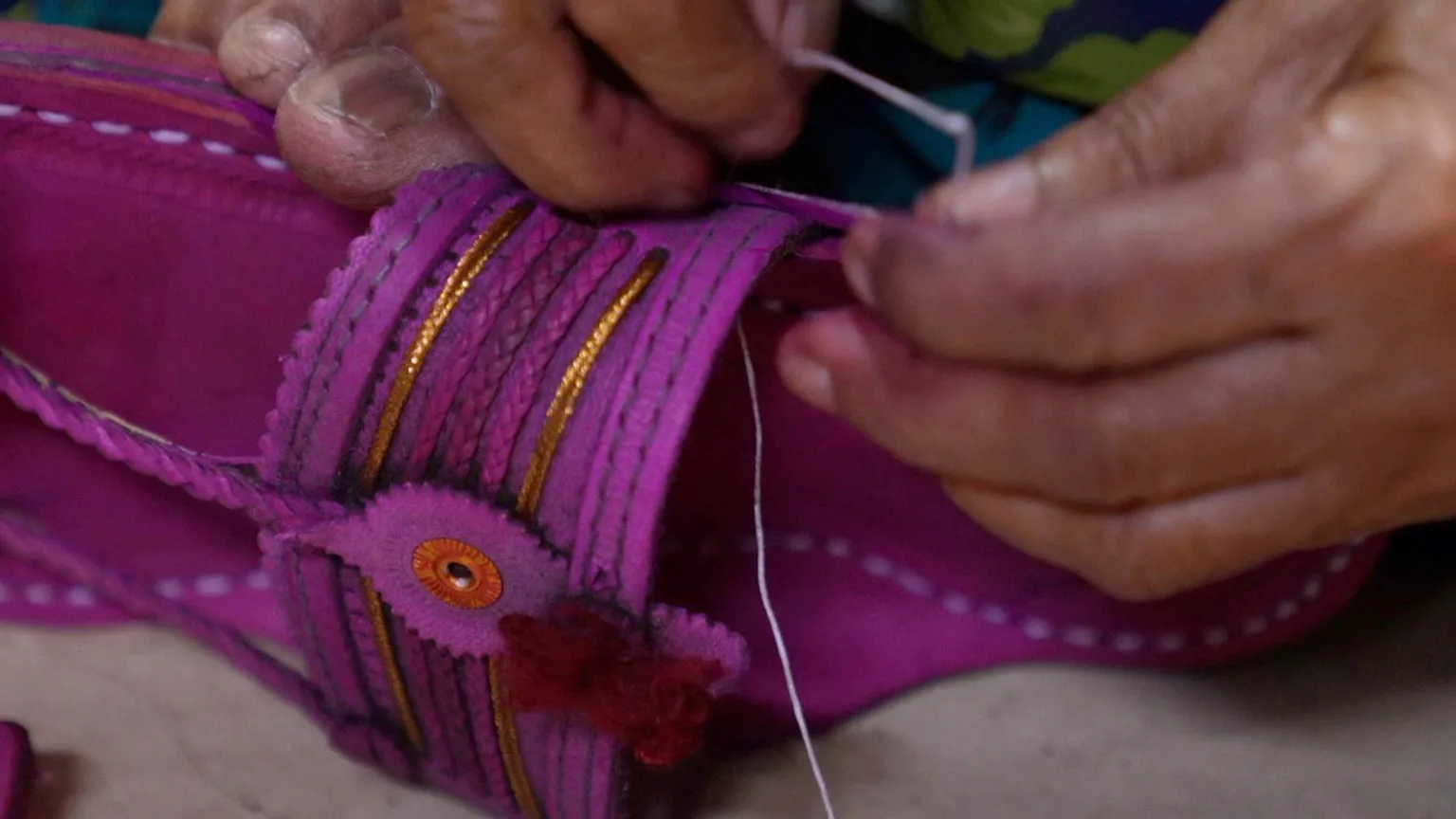Amid the rich tributes to Danish Siddiqui from across the world, the Editors Guild of India had to issue a statement. Though the Guild mourned over this untimely death and stated, ‘His death is an occasion to remember him and all the journalists who have died in conflict reporting’, it also referred to the hate campaign that broke out hours after his death:‘…The Guild is deeply disturbed by the vicious and highly regrettable racist campaign being run against him by some sections of social media.’
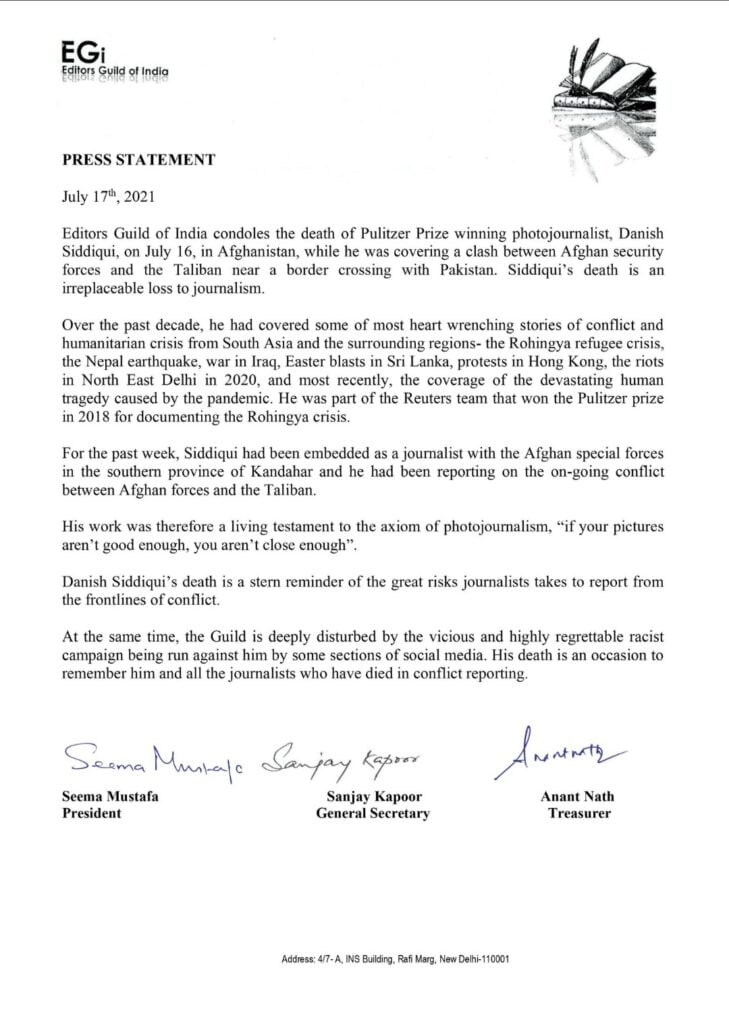
So vicious were some of the right-wing trolls, that the former Jammu and Kashmir chief minister Omar Abdullah tweeted to condemn the obnoxious celebration that followed his death.
Also read: Sulli Deals: An Everyday Reality For Muslim Women In India
One Twitter user named Yoda tweeted: ‘Last took photos of Hindu cremations at the peak of 2nd wave and splashed it across foreign media to not only demean India but also to degrade Hinduism.’
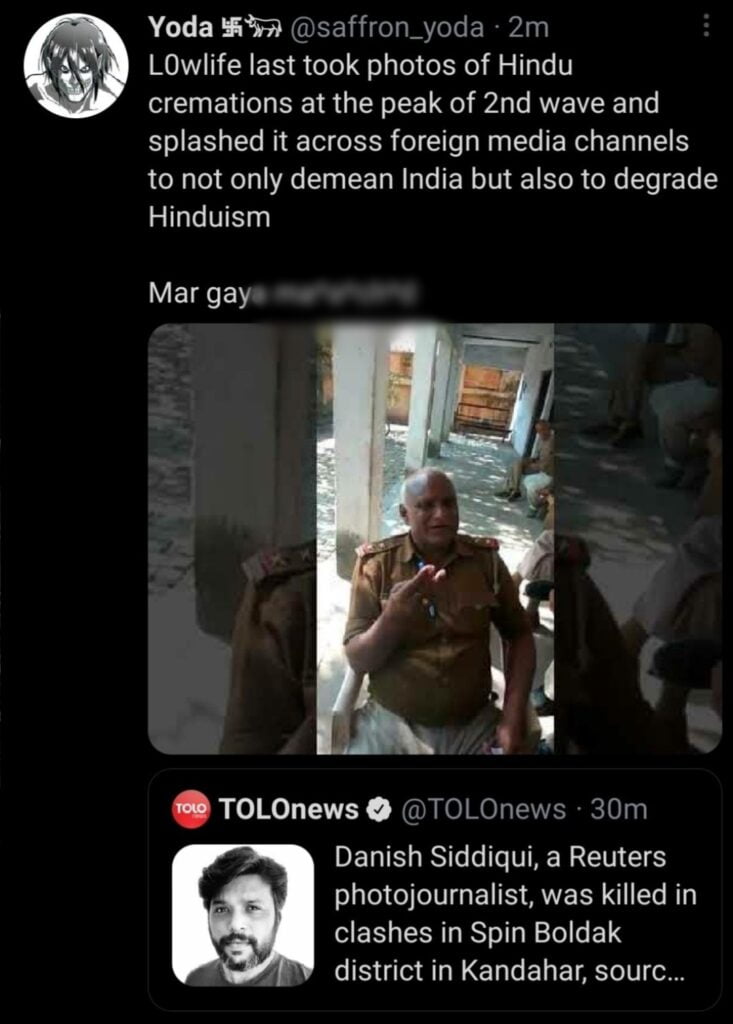
Another account user Rishabh wrote: ‘This probably the best news today (sic). Took these drone shots. Very good. Got what he deserved.”
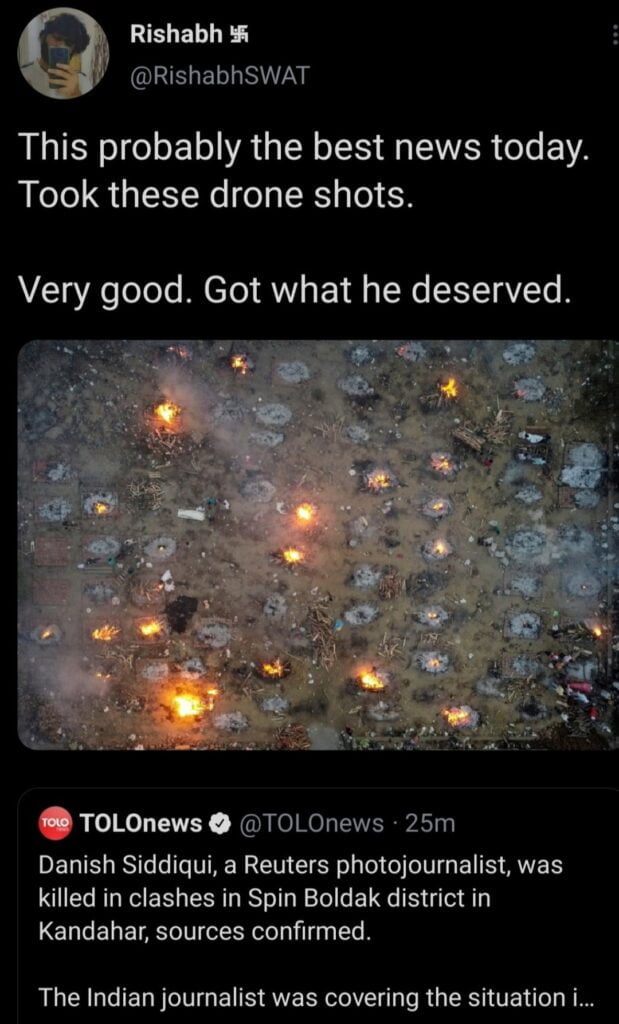
A lot of other tweets rejoiced over how ‘Karma’ had finally spoken by punishing Danish Siddiqui.
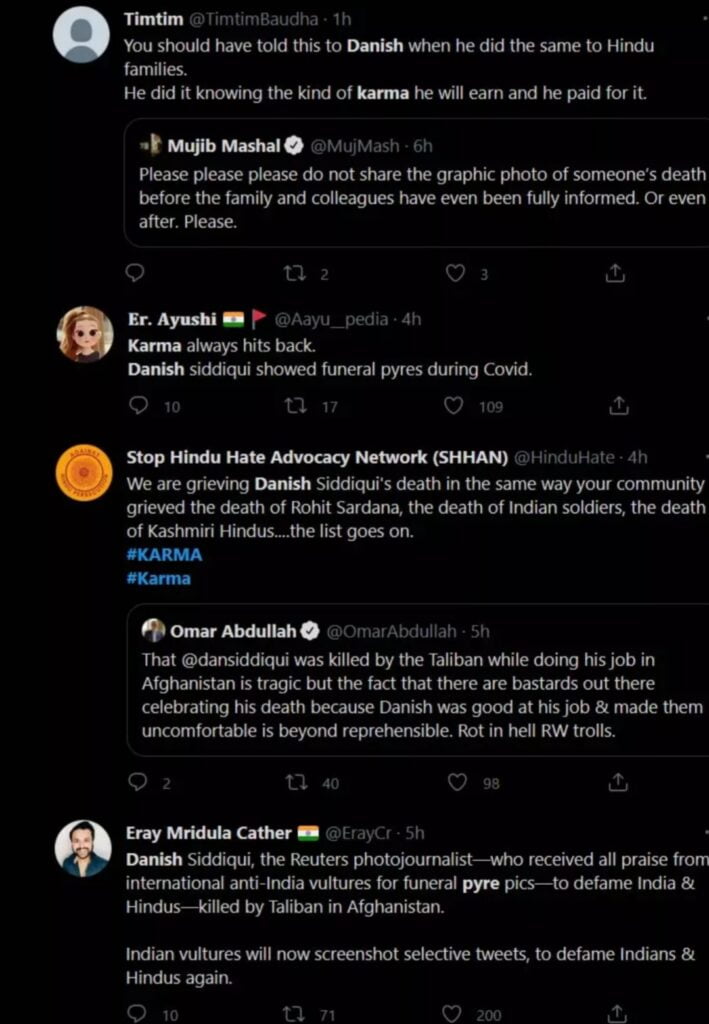
Anand Shridhar wrote: “Siddiqui violated the sacred funeral rites of hundreds of Hindus with his drone stunt to build a narrative.” Kaushal B, who claims to be a writer and ABVP Jalandhar activist on his Twitter bio, wrote: “Sorry to say! But I feel no such mourning & grievance with the death of Siddiqui.”
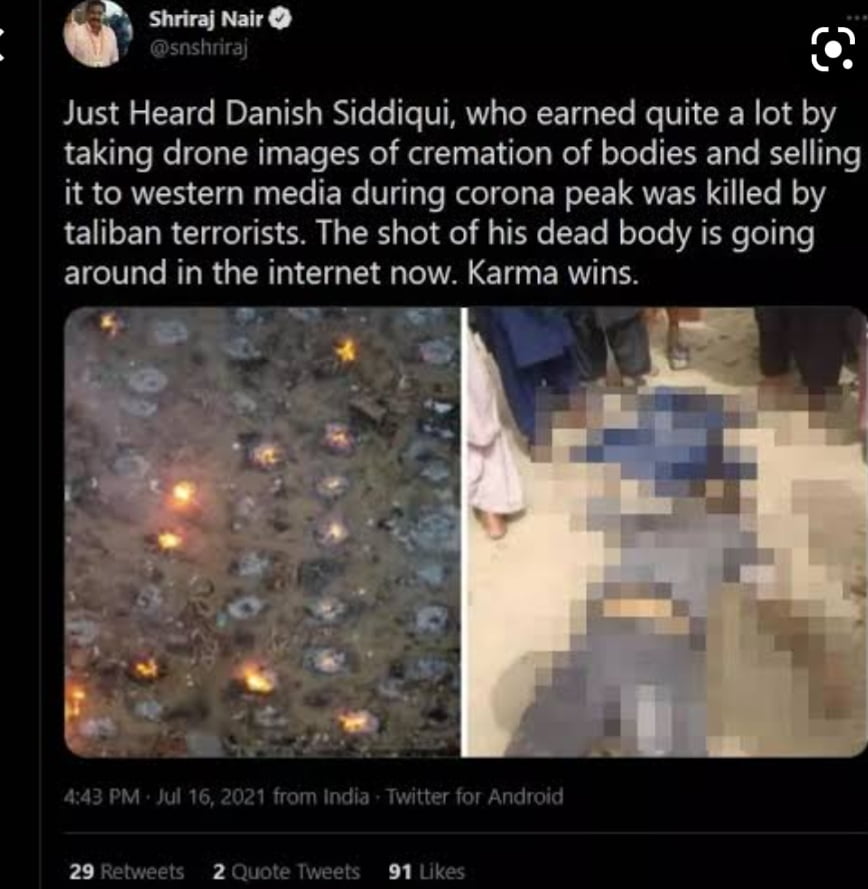
The hostility on social media is mainly because of his body of work, that speaks out loud against the ruling government, though the celebration over his demise undeniably also has to do with the hatred towards Muslims, evident in the country at present. A Muslim man, as an ‘other’, does not deserve empathy, or merely sympathy, even after death, according to the Hindutvavadis, it seems. Moreover, Danish Siddiqui’s death has been imagined as a punishment, designed by some supreme heavenly power, for bringing to light the Indian government’s mishandling of COVID-19. Siddiqui’s documentation of truth fetched global attention, maligned the image of the government and made it accountable for its poor leadership. Such audacity is evidently intolerable, especially when coming from a Muslim man.
Also read: How COVID-19 Second Wave Devastated Rural India
Danish Siddiqui’s death has been imagined as a punishment, designed by some supreme heavenly power, for bringing to light the Indian government’s mishandling of COVID-19. Siddiqui’s documentation of truth fetched global attention, maligned the image of the government and made it accountable for its poor leadership. Such audacity is evidently intolerable, especially when coming from a Muslim man.
The Reuters photojournalist was killed on 15th July, 2021 in Kandahar while reporting a clash between Afghan Special Forces and Taliban attackers. One may not have the expertise to comment on his proficiency as a photojournalist, but one can surely delineate the impact his photography had on laypersons. When in 2018, Danish Siddiqui and his colleague Adan Abidi took a photograph of an exhausted Rohingya refugee woman touching the shore, after crossing the Bangladesh-Myanmar border, the misery of thousands of landless, country-less refugees overwhelmed us. That single photograph told what a thousand words might not tell about the global migrant crisis. It was this photograph that won Danish Siddiqui the coveted Pulitzer. He chose to speak the truth through his photos, whatever might be the price. He covered the wars in Afghanistan and Iraq, the Hong Kong protests and Nepal earthquakes.
At home, he shot pictures of the farmers’ protests, clicked pictures of the military troops in Kashmir. The drone picture of the funeral pyres burning round-the-clock and cremation grounds running out of space told the story of the COVID-19 death toll unacknowledged in official data. And one cannot help not recall the Muslim man in a white kurta, crouching on the road as a mob surrounds him, sticks raised.
Danish Siddiqui’s lens became the vigilant eyes of the collective. ‘I shoot for the common man who wants to see and feel a story from a place where he can’t be present himself,‘ he had said.
Danish Siddiqui attempted to mirror the truth objectively and relentlessly. That in turn served to keep the citizens’ conscience in check. Hence he was bound to be a potential threat to the oppressive State.
In 1993, the New York Times published a picture of the famine-stricken Sudan, where a child was trying to reach the UN relief camp, while an eagle was waiting to hunt her down. Many said that the photographer could have saved the baby instead of taking pictures. Photographer Kevin Carter died by suicide four months after receiving the Pulitzer Award for the said still photo, bringing forth the ethical conflict between professional and humanitarian commitments that a photographer often faces.
Danish tried to strike a balance between the two. He had walked away from the scene soon after photographing the crouching Mohammed Zubair amidst the blood-thirsty mob, as he was trained to do so. But Siddiqui traced back Zubair later, returned to him, tracked his recovery in the following days and apologised to him for walking away from the scene without being able to intervene.
Danish Siddiqui was not only compassionate towards the subjects of his photography, he might have identified with them. As a person belonging to the minority community in present-day India, the fear of being attacked for his Muslim identity while taking pictures might have haunted him time and again.
Featured image source: Free Press Journal
About the author(s)
Satabdi Das is an activist, author, teacher. She is the editor of Khader Dhare Ghor (A House By The Canyon: A book on Domestic Violence), has authored Naribadi Chithi O Onyanyo (Feminist Letters and Others) and O-Nandonik Golpo-Sonkolon (The Unaesthetic Stories). Her areas of work are domestic violence, sexual violence and inequalities in school-curricullum. She can be found on Facebook and Twitter.
